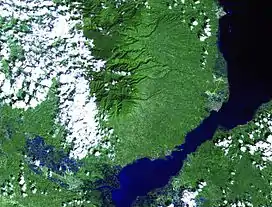| Mount Malindang | |
|---|---|
 Landsat image of Mount Malindang and its vicinity | |
| Highest point | |
| Elevation | 2,404 m (7,887 ft)[1][2][3] |
| Prominence | 2,290 m (7,510 ft)[2] |
| Listing |
|
| Coordinates | 8°13′03″N 123°38′12″E / 8.21750°N 123.63667°E[2][1] |
| Geography | |
.svg.png.webp) Mount Malindang .svg.png.webp) Mount Malindang | |
| Country | Philippines |
| Region | Northern Mindanao |
| Province | Misamis Occidental |
| Parent range | Malindang Mountain Range |
| Geology | |
| Mountain type | [1] |
| Volcanic arc/belt | Sulu-Zamboanga Arc |
| Last eruption | 1819 (unofficial) possibly in 1822 |
| Climbing | |
| First ascent | Maj. E.A. Mearns, W.I. Hutchinson, and party in May 1906[4] |
Mount Malindang is a complex volcano located in the province of Misamis Occidental in the southern island of Mindanao, Philippines. It is the highest point in the province. The least studied mountain range was formed through several volcanic activities some of which could be historical, evident by the presence of two calderas, surrounded by high rock walls, cinder cones, dome volcano plugs, two sulfurous hot springs, and a crater lake named Lake Duminagat. The amphitheater structures have extensive distribution of volcanic rocks, carbonized wood that are found in pyroclastic deposits. The mountain range is dissected by several canyons and ravines.[5]
Classification
Malindang has unofficially historical eruptions but it believed to be in 1822 and is classified as inactive by the Philippine Institute of Volcanology and Seismology.[6]
Mount Malindang Natural Park
Mount Malindang and the whole Malindang Mountain Range's alluring qualities come from its waterfalls, crater lake and dense virgin forests which host diverse and rare species of flora and fauna. On June 19, 1971, the area was proclaimed as Mount Malindang National Park by virtue of Republic Act 6266.[7] Under the establishment of National Integrated Protected Areas System (NIPAS) in 1992, the park was reclassified and was renamed as Mount Malindang Range Natural Park on August 2, 2002 through Proclamation No. 228.[8]
The park encompasses three provinces – Misamis Occidental, Zamboanga del Sur and Zamboanga del Norte – covering an area of 53,262 hectares (131,610 acres) of which about 33,000 hectares (82,000 acres) or 62% of forest remaining. About 20,000 hectares (49,000 acres) are cultivated and inhabited by indigenous people mostly the Subanon tribe.[5][9]
Fauna
The national park is known to harbor a rich and unique biodiversity that is yet to be explored. The mountain and its outlying areas, some unexplored, are home to some of the endemic and endangered species in the Philippines, which include:.[5]
- Greater Mindanao shrew (Crocidura grandis)
- Tarsier (Carlito syrichta)
- Flying lemur (Cynocephalus volans)
- Long-tailed macaque (Macaca fascicularis)
- Philippine deer (Cervus mariannus)
- Asian palm civet (Paradoxurus hermaphroditus subsp. philippinensis)
- Philippine warty pig (Sus philippensis)
- Rough-armed tree frog (Kurixalus appendiculatus)
- Marbled water monitor (Varanus marmoratus)
- Philippine hawk-eagle (Nisaetus philippensis)
- Philippine eagle (Pithecophaga jefferyi)
- Rufous hornbill (Buceros hydrocorax)
- Philippine hanging parakeet/colasisi (Loriculus philippensis)
- Philippine pygmy woodpecker (Dendrocopos maculatus)
Economic importance
Mount Malindang and its adjoining mountain range including Dapitan Peak and Mt Bliss, is a catchment area which drains water through 49 rivers and streams, and numerous creeks. It provides potable water for domestic, agricultural and other uses to more than one million inhabitants of Misamis Occidental and the eastern parts of Zamboanga del Norte and Zamboanga del Sur.[10]
ASEAN Heritage Park
Declared as Association of Southeast Asian Nations (ASEAN) Heritage Park (AHP), during the 13th Informal ASEAN Ministerial Meeting on the Environment held October 13, 2011, in Cambodia. The three other Philippine AHPs are Mount Iglit-Baco National Park in Mindoro, Mount Kitanglad Range in Bukidnon, and Mount Apo Natural Park in Davao.[11]
It was officially launched on August 4, 2012, during the 2nd National ASEAN Heritage Park (AHP) Conference, sponsored by the ASEAN Center for Bio-diversity (ACB) at Oroquieta City.[12]
See also
References
- 1 2 3 "Malindang". Global Volcanism Program. Smithsonian Institution.
- 1 2 3 de Ferranti, Jonathan; Maizlish, Aaron. "Philippine Mountains – 29 Mountain Summits with Prominence of 1,500 meters or greater". Retrieved October 29, 2008.
- ↑ "Mount Malindang, Philippines". Peakbagger.com. Retrieved November 5, 2008.
- ↑ Merrill, Elmer D. (1907_06). "Ascent of Mount Halcon", p.180. Philippine Journal of Science, Vol.II No.3.
- 1 2 3 "Mt. Malindang Range Natural Park on UNESCO World Heritage". UNESCO. Archived from the original on June 16, 2018. Retrieved October 28, 2008.
- ↑ "Inactive Volcanoes Part 5". Philippine Institute of Volcanology and Seismology. Retrieved March 19, 2019.
- ↑ "List of Initial Components Under the NIPAS". Protected Areas and Wildlife Bureau. Archived from the original on March 20, 2012. Retrieved March 19, 2019.
- ↑ "Proclamation No. 228, s. 2002". Official Gazette of the Republic of the Philippines. Archived from the original on March 19, 2019. Retrieved March 19, 2019.
- ↑ "Mount Malindang National Park". Archived from the original on October 21, 2009. Retrieved October 28, 2008.
- ↑ "Mount Malindang Range Natural Park" (PDF). Department of Environment and Natural Resources. Retrieved October 28, 2008.
- ↑ "Mindanao's Mount Malindang Range Natural Park declared ASEAN Heritage Park". Manila Bulletin. November 13, 2011. Archived from the original on February 5, 2012. Retrieved March 19, 2019.
- ↑ "Mt. Malindang: The newly-declared ASEAN Heritage Park in the Philippines". Department of Environment and Natural Resources. Archived from the original on April 24, 2015. Retrieved March 19, 2019.
External links
- ):):):):):):)
